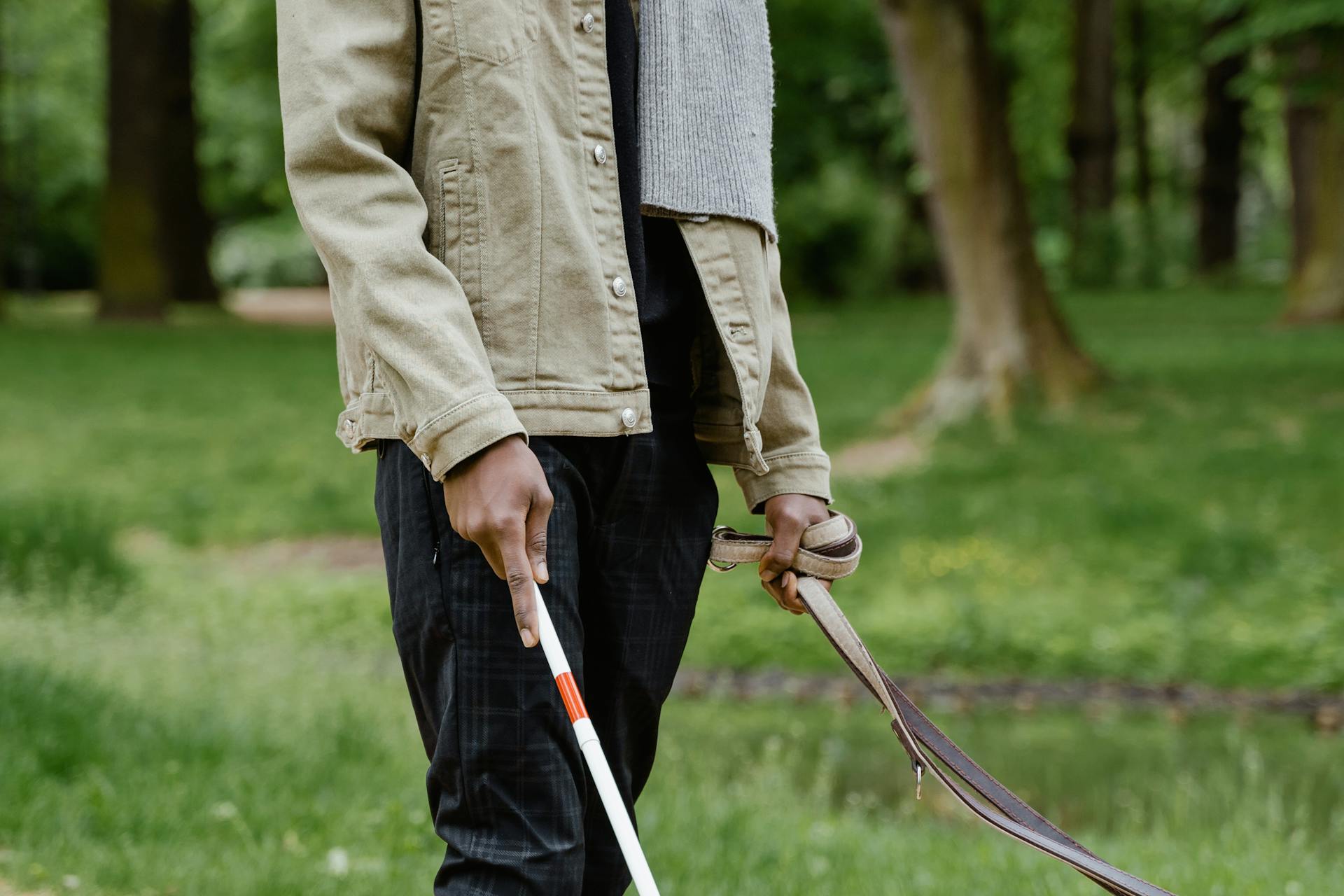
Hip dysplasia is a common issue in dogs that affects their hip joints, causing arthritis and mobility problems.
Dogs with hip dysplasia often experience pain and discomfort, especially after exercise or long walks.
Managing hip dysplasia in dogs requires a comprehensive approach that involves exercise modification, weight management, and pain relief.
Regular exercise can actually help improve hip mobility in dogs with hip dysplasia, but it's essential to choose low-impact activities that don't put excessive strain on their joints.
Explore further: My Dog Is Limping but Shows No Sign of Pain
Symptoms and Signs
Symptoms of hip dysplasia in dogs can be quite subtle, but they're essential to recognize early on. Some dogs may start showing signs as young as four months old.
Decreased activity is a common symptom, as the pain and discomfort can make it difficult for your dog to move around freely.
Dogs with hip dysplasia may also experience a decrease in range of motion, making it harder for them to jump, run, or climb stairs.
Lameness in the hind end is another telltale sign, where your dog may limp or show reluctance to move around.
A "bunny hopping" gait is a classic sign of hip dysplasia, where your dog may hop or skip instead of walking normally.
Some dogs may also exhibit grating in the joint during movement, which can be a sign of loose joints.
In severe cases, hip dysplasia can lead to loss of thigh muscle mass and noticeable enlargement of the shoulder muscles.
Pain and stiffness are also common symptoms, which can cause your dog to limp or show reluctance to move around.
Here are some common signs of hip dysplasia in dogs:
- Chronic or occasional lameness
- Limping with no previous trauma or injury
- “Bunny hopping,” particularly when climbing stairs
- Having trouble standing up
- Abnormal sitting positions
- Having trouble getting on and off furniture, going upstairs, or jumping into cars
Treatment and Management
If your veterinarian diagnoses your dog with hip dysplasia, they may recommend a comprehensive treatment plan that includes joint supplements like glucosamine.
Large breed dog foods often contain joint supplements like glucosamine, which can be a great starting point for supporting your dog's joint health.
Curious to learn more? Check out: Hip & Joint Dog Treats
Glucosamine and chondroitin supplements are safe for long-term use in most patients and may help reduce symptoms of hip dysplasia.
You can also purchase supplements for dogs that might be prone to developing arthritis and hip dysplasia down the line, as an early intervention to help prevent the progression of the condition.
Physical rehabilitation can also be a valuable tool in managing hip dysplasia, helping dogs improve their range of motion, increase their mobility, and ease pain.
Natural Remedies for Dogs
Natural Remedies for Dogs can be a great way to alleviate hip dysplasia pain and improve their quality of life.
Glucosamine supplements, often found in large breed dog foods, can help reduce symptoms of hip dysplasia.
Joint supplements like glucosamine and chondroitin are safe for long-term use in most patients.
You can also purchase supplements with these ingredients for dogs prone to developing arthritis and hip dysplasia.
Always talk with your vet before making any changes to your dog's daily routine, as they can help you create a custom treatment plan.
Some natural remedies, such as glucosamine, may help reduce symptoms of hip dysplasia.
Physical therapy, including passive and active stretches, massages, and range-of-motion exercises, can help improve mobility and ease pain.
Your vet can work with your dog on a customized treatment plan to follow at home.
Check this out: English Bulldog Hip Dysplasia Treatment
Weight Management
Keeping your dog at an ideal weight is crucial in managing joint pain. This is because excess weight puts additional stress on joints, leading to increased inflammation and pain.
Excess body fat produces inflammation, which worsens joint pain. Speak to your veterinarian about a weight-management plan to prevent this.
A healthy weight can significantly reduce joint pain caused by increased weight and inflammation. Regular check-ups with your veterinarian can help monitor your dog's weight and adjust the plan as needed.
Keeping your dog at an ideal body condition will ensure they don't suffer from excess inflammation and weight on their joints.
Worth a look: Dog Body Language with Other Dogs
Diagnosis and Detection
Your veterinarian will perform a physical exam to suspect hip dysplasia, which may include manipulating your dog's hind legs to test the looseness of the joint.
A physical exam may also include blood work to check for inflammation due to joint disease.
Your veterinarian will need a history of your dog's health and symptoms, as well as any possible incidents or injuries that may have contributed to these symptoms.
A radiograph or X-ray is usually necessary to determine the degree and severity of the hip dysplasia, which will help determine the best course of treatment for your dog.
These X-rays will show the looseness of the joint and help your veterinarian understand the extent of the condition.
Walking and Exercise
Walking and exercise are essential for your dog's overall health, especially when it comes to hip dysplasia. Exercise is vital for controlling your dog's weight and keeping their muscles active.
Walking on a soft surface like grass or sand can be the perfect workout for your dog, as it reduces the impact on their joints compared to hard surfaces. Walking up hills can even help increase muscle development and improve your dog's overall mobility.
Regular walks can help strengthen your dog's muscles, which can help alleviate some of the symptoms associated with hip dysplasia.
Readers also liked: How to Walk a Human a Dog's Guide?
Sources
- https://vcahospitals.com/know-your-pet/hip-dysplasia-in-dogs
- https://www.akc.org/expert-advice/health/hip-dysplasia-in-dogs/
- https://www.petmd.com/dog/conditions/musculoskeletal/c_dg_hip_dysplasia
- https://www.dailypaws.com/dogs-puppies/health-care/senior-dog-health/hip-dysplasia
- https://www.akcpetinsurance.com/blog/natural-remedies-hip-dysplasia-dogs
Featured Images: pexels.com


